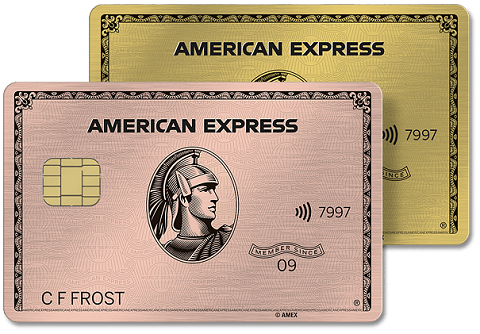Chase Sapphire Reserve vs. American Express Gold: Luxury Travel Benefits or Foodie Perks

If you’re considering both the Chase Sapphire Reserve® and the American Express® Gold Card, an advertising partner, you want a card that rewards you for spending on travel and dining, earning you valuable points for future travel along with lifestyle benefits you can use when you’re closer to home.
Here’s everything you need to know to pick the right card for you, including an in-depth comparison of benefits, annual fees, rewards and more.

400+ Credit Cards
Analyzed independently across 50+ data points in 30+ product categories

Reviewed
By a team of credit card experts with an average of 9+ years of experience

Trusted by
More than one million monthly readers seeking unbiased credit card guidance
CardCritics™ editorial team is dedicated to providing unbiased credit card reviews, advice and comprehensive comparisons. Our team of credit card experts uses rigorous data-driven methodologies to evaluate every card feature, fee structure and rewards program. In most instances, our experts are longtime members or holders of the very programs and cards they review, so they have firsthand experience maximizing them. We maintain complete editorial independence — our ratings and recommendations are never influenced by advertiser relationships or affiliate partnerships. You can learn more about our editorial standards, transparent review process and how we make money to understand how we help you make informed financial decisions.
How the Cards Compare: Chase Sapphire Reserve vs. Amex Gold
Side By Side Comparison
Annual Fee
Purchase and Balance Transfer APR
Welcome Offer
Ongoing Rewards
Earn 4X Membership Rewards® points per dollar spent at US supermarkets, on up to $25,000 in purchases per calendar year, then 1X points for the rest of the year.
Earn 3X Membership Rewards® points per dollar spent on flights booked directly with airlines or on AmexTravel.com.
Earn 2X Membership Rewards® points per dollar spent on prepaid hotels and other eligible purchases booked on AmexTravel.com.
Earn 1X Membership Rewards® point per dollar spent on all other eligible purchases.
Pros & Cons
- Luxury Perks
- 1:1 Transfer Partners
- Premium Travel Protections
PROS
- High annual fee
- No intro APR for purchases or balance transfers
- Might not make sense for people who aren’t frequent travelers
CONS
- Generous Welcome Offer Opportunity
- Elevated rewards on popular categories
- Choose between a Rose Gold or Gold Card
PROS
- Steep Annual Fee
- Light on Travel Perks
CONS
Learn More
Welcome Offers
Both cards come with lucrative welcome offers, which can set you up with a nice stash of points toward your next award trip. The Sapphire Reserve’s welcome offer gets you more points, but it also requires meeting a higher minimum spending requirement in a shorter period of time.
Chase Sapphire Reserve Welcome Offer
The Chase Sapphire Reserve is currently offering new cardholders 125,000 points after they spend $6,000 on purchases in the first three months from account opening. This is the highest welcome offer we’ve ever seen on this card, which is no coincidence; Chase launched this extra-generous bonus to coincide with the launch of new perks and a higher annual fee on the Sapphire Reserve (more on that later).
Amex Gold Welcome Offer
The Amex Gold Card is running a strong welcome offer: You may be eligible for as high as 100,000 Membership Rewards® Points after spending $6,000 in eligible purchases on your new Card in your first 6 months of Membership. Welcome offers vary and you may not be eligible for an offer. You’ll need to apply to see the exact welcome offer that you qualify for, but in any case, even with the $6,000 minimum spending requirement, you have twice the amount of time to meet it compared to the Chase Sapphire Reserve’s offer.
That said, the Sapphire Reserve offer is for 25,000 more points than the highest Amex Gold welcome offer.
CardCritics™ Opinion
The Chase Sapphire Reserve comes out ahead in terms of the overall value you get from the welcome offer, as 125,000 Chase Ultimate Rewards® points objectively beat a maximum of 100,000 American Express Membership Rewards® points.
That said, there are a few caveats that could change the calculus for you. First, you only have three months to meet the minimum spending requirement for the Sapphire Reserve’s welcome bonus, compared to six months for the Amex Gold. If you already spend more than $6,000 on your credit cards in a three-month period, this won’t make a difference, but if that amount is a stretch, you’re probably better off going with the Amex Gold.
Additionally, you’ll want to consider the two cards’ respective rewards currencies. Chase Ultimate Rewards® and Amex Membership Rewards points are both quite valuable, but the right option for you will come down to which airlines and hotels you prefer to book with. We’ll get into details of each program’s transfer partners in the Redeeming Rewards section.
Earning Rewards
Both the Chase Sapphire Reserve and Amex Gold Card have valuable bonus categories to help you rack up points quickly. Each is targeted toward travelers who enjoy a good meal out (or in), but there are some notable differences.
How To Earn Rewards With Chase Sapphire Reserve
The Sapphire Reserve’s rewards structure rewards travel purchases the most heavily. You’ll earn:
- 8x points on all purchases through Chase Travel℠, including The Edit
- 4x points on flights booked direct
- 4x points on hotels booked direct
- 3x points on dining worldwide
- 1 point per dollar on all other purchases
How To Earn Rewards With Amex Gold
The Amex Gold also rewards travel purchases handsomely, but the main focus is food. Cardholders earn:
- 4x points at restaurants worldwide (on up to $50,000 in purchases each year, then 1 point per dollar)
- 4x points on groceries at U.S. supermarkets (on up to $25,000 in purchases per year, then 1 point per dollar)
- 3x points on flights booked directly with airlines or on AmexTravel.com
- 2x points on prepaid hotels and other eligible travel purchases booked through AmexTravel.com
- 1 point per dollar on everything else.
CardCritics™ Opinion
This is another category where the better pick depends on you — and, specifically, what you spend the most money on.
If you spend more on travel than dining and groceries from U.S. supermarkets, you’ll probably come out ahead with the Chase Sapphire Reserve. However, it’s important to note that the Sapphire Reserve’s most lucrative bonus category is 8x points on travel booked through Chase Travel, including The Edit). If you like the options you find through Chase’s own platform, this is great news, but you’ll have fewer options (and, sometimes, higher prices) than if you book directly with an airline or hotel.
It’s also worth noting the spending caps on the restaurants worldwide and groceries at U.S. supermarkets categories on the Amex Gold, though the annual thresholds are high enough that most cardholders should never max out. But if you have a big family or put a few large events’ worth of purchases on the card, you could hit the cap.
Redeeming Rewards
With either card, the best way to redeem your points is to move them over to transfer partners. The Amex Membership Rewards and Chase Ultimate Rewards programs partner with airlines and hotels, and using your points to book travel through these loyalty programs can often score you incredible value. We’ll walk through the highlights of each, as well as the other ways to redeem your credit card rewards in each program.
How To Redeem Rewards With Chase Sapphire Reserve
You can redeem the Ultimate Rewards points you earn from the Sapphire Reserve in a few different ways:
- Cash in the form of a statement credit or direct deposit
- Shop with points on Amazon
- Gift cards
- Book travel through the Chase Travel portal
- Transfer to Chase transfer partners, including United Mileage Plus, Southwest Rapid Rewards and World of Hyatt
How To Redeem Rewards With Amex Gold
Similarly, you have a few different options for redeeming Membership Rewards points earned on the Amex Gold Card:
- Pay with points on Amazon and other select retailers
- Redeem for gift cards
- Get cash in the form of a statement credit
- Book travel through AmexTravel.com
- Transfer to American Express transfer partners, such as Delta SkyMiles, Air Canada Aeroplan and Hilton Honors
CardCritics™ Opinion
The Amex Membership Rewards program has more transfer partners than Chase Ultimate Rewards, but for many U.S.-based travelers, Chase’s selection of partners will be more valuable. For example, if you mostly fly domestically, you might care more about Chase’s partnership with Southwest and United than the extensive international airline partners available through Amex.
Another standout partner of the Chase Ultimate Rewards program is World of Hyatt. You can get amazing value thanks to this program’s generous award chart.
Also note that there is significant overlap with transfer partners in both programs: Both partner with Air Canada Aeroplan, JetBlue TrueBlue, Marriott Bonvoy, Singapore Airlines KrisFlyer and others.
Card Benefits
No matter which card you choose, you’ll have a long list of perks to enjoy. The Sapphire Reserve has more travel benefits, but the Amex Gold is no slouch in this regard either, even though its focus is more on dining perks.
Chase Sapphire Reserve Benefits
It’s no wonder this card ranks highly among the best Chase credit cards; the list of Chase Sapphire Reserve benefits is extremely long.
Let’s start with the statement credits:
- $300 annual travel credit each account anniversary year
- $500 credit for stays with The Edit, awarded as up to $250 in statement credits from January through June and again from July through December for prepaid bookings made with The Edit, with a two-night minimum required.
- $300 dining credit, awarded as up to $150 in statement credits from January through June and again from July through December for a maximum of $300 annually at restaurants that are part of Sapphire Reserve Exclusive Tables
- DoorDash DashPass membership when you activate by Dec. 31, 2027
- $300 in annual DoorDash promos, up to $25 each month, including a $5 monthly promo to spend on restaurant orders and two $10 promos each month to save on groceries, retail orders, and more (through Dec. 31, 2027)
- $300 StubHub credit, awarded as up to $150 in statement credits from January through June and again from July through December for a maximum of $300 annually for StubHub and viagogo purchases through Dec. 31, 2027
- $250 Apple TV+ annual subscription credit through June 22, 2027
- $120 in annual Lyft credits, awarded as up to $10 in monthly in-app credits — and 5x total points on Lyft rides through Sept. 30, 2027
- $120 in annual credits for eligible Peloton memberships, awarded as $10 in statement credits per month through Dec.31, 2027, with activation required, and 10x total points on eligible Peloton equipment and accessory purchases over $150 through the same date
- Up to $120 in statement credits for Global Entry, TSA PreCheck or NEXUS, available once every four years after the first program application fee is charged to your card
The statement credits are plentiful, especially with the recent update to the Chase Sapphire Reserve, which added new benefits and a higher annual fee. But the card also has a handful of airport lounge access benefits worth mentioning in their own list:
- Airport lounge access via the Chase Sapphire Lounge by The Club network, with two complimentary guests
- Priority Pass Select membership, with complimentary access for the primary cardmember and up to two accompanying guests
- Access to select Air Canada Maple Leaf Lounges and Air Canada Cafés in the US, Canada and Europe with an eligible boarding pass
It’s also worth mentioning the Sapphire Reserve’s travel protection benefits, which can save you money, time and stress if things go wrong during one of your trips:
- Primary auto rental coverage
- Trip cancellation/interruption insurance
- Trip delay reimbursement
- Roadside assistance
- Emergency evacuation and transportation
Finally, with the card’s latest big update, it added a suite of perks that can only be unlocked by spending $75,000 or more on the card in a calendar year. These include:
- IHG One Rewards Diamond Elite Status
- A $250 credit for The Shops at Chase
- $500 Southwest Airlines Chase travel credit and A-List status
That’s a lot to digest, and we wouldn’t blame you if your head is spinning.
Amex Gold Benefits
Moving on to Amex Gold benefits, the list is slightly shorter — but still pretty impressive, especially if you love to splurge on fancy meals. First, let’s tackle the statement credits:
- $120 in annual Uber Cash, awarded as $10 each month to use on orders and rides in the U.S. when an Amex card is selected for the transaction
- Up to $84 in annual Dunkin’ credit, awarded as up to $7 in monthly statement credits when you pay with the card at U.S. Dunkin’ locations. Enrollment required.
- Up to $100 in statement credits each year (up to $50 in statement credits semi-annually) after you pay with the card at U.S. Resy restaurants or make eligible Resy purchases (enrollment required)
- Up to $120 in annual dining credits, up to $10 each month, at participating partners, including Grubhub, The Cheesecake Factory, Goldbelly, Wine.com and Five Guys (enrollment required)
- $100 credit towards eligible charges when you book two nights or more with The Hotel Collection through AmexTravel.com
Like the Chase Sapphire Reserve, the Amex Gold comes with several travel protection perks, including:
- Car rental loss and damage insurance (though note that coverage is secondary, rather than primary, for most locations)
- Global Assist Hotline
- Baggage insurance and trip delay insurance
CardCritics™ Opinion
The Chase Sapphire Reserve is the clear winner when it comes to benefits, not just in terms of the sheer number of perks it offers, but also in the value they represent. Unlike the Amex Gold Card, it offers airport lounge access, and its travel benefits — spanning both statement credits and protection features like primary car rental insurance — are more generous.
Both cards have been (fairly) criticized for developing “coupon book syndrome,” meaning that so many of their benefits are awarded as monthly or semi-annual statement credits that require spending cash up front to get money back. That said, if you’re planning on making the eligible purchases in the first place, you can save real money by taking advantage.
Make sure to read all the terms and conditions, no matter which card you choose. With both cards, for instance, you’ll need to manually enroll to receive certain benefits.
Fees and Costs
At $795 per year, the Chase Sapphire Reserve has the higher annual fee compared to the Amex Gold Card. Neither card charges foreign transaction fees, and neither comes with an introductory APR offer on purchases or balance transfers, either, reflecting the fact that these cards are targeted toward individuals with good to excellent credit.
Chase Sapphire Reserve Fees and Costs
The Chase Sapphire Reserve has a $795 annual fee, making it the more expensive pick.
It charges the following fees:
- Authorized user fee of $195 per year
- Late payment and return payment fees of up to $40
- Purchase APR and balance transfer APR of 19.74% - 28.24% Variable
- Cash advance and balance transfer fee of either $10 or 5% the amount of each transaction, whichever is greater
- Cash advance APR of 28.99%
Amex Gold Fees and Costs
At $325, the Amex Gold Card’s annual fee is more modest than the Chase Sapphire Reserve’s, but still quite substantial. Here are the other main charges to note:
- Late payment and return payment fees of up to $40
- Penalty APR of 29.99%
- Cash advance fee of either $10 or 5% the amount of each cash advance, whichever is greater
- Cash advance APR of 29.24%
CardCritics™ Opinion
The Amex Gold technically wins this category, as it has the lower annual fee of the two. But you’ll need to decide which card’s benefits and bonus rewards categories make the most sense for you; the Chase Sapphire Reserve could still be a better pick if you value its travel perks.
How To Choose Between Chase Sapphire Reserve vs American Express Gold
If you’re comparing the Amex Gold vs. the Chase Sapphire Reserve, take an honest look at your average annual spending and evaluate how it lines up with the benefits and earning rates of each card.
If you travel several times a year, want airport lounge access and can leverage the statement credits for streaming and Lyft, the Sapphire Reserve could be worth it, despite the higher annual fee.
On the other hand, if you don’t travel as frequently but you still want to maximize the travel purchases you do make — and you regularly spend on dining in and eating out — the Amex Gold is likely a safer bet.
Make sure you do the math to ensure you’re getting enough value in exchange for the annual fee, but either option is a fantastic travel rewards card for maximizing your spending and earning towards your next award trip.
For the Baggage insurance plan on the American Express® Gold Card, Eligibility and Benefit level varies by Card. Terms, Conditions and Limitations Apply. Please visit americanexpress.com/benefitsguide for more details. Underwritten by AMEX Assurance Company.
For the Car rental loss and damage insurance on the American Express® Gold Card, Eligibility and Benefit level varies by Card. Terms, Conditions and Limitations Apply. Please visit americanexpress.com/benefitsguide for more details. Underwritten by AMEX Assurance Company.
For the Trip Delay Insurance on the American Express® Gold Card, Eligibility and Benefit level varies by Card. Terms, Conditions and Limitations Apply. Please visit americanexpress.com/benefit sguide for more details. Underwritten by New Hampshire Insurance Company, an AIG Company.
For the Global Assist Hotline on the American Express® Gold Card, Eligibility and Benefit level varies by Card. Terms, Conditions and Limitations Apply. Please visit americanexpress.com/benefit sguide for more details. Card Members are responsible for the costs charged by third-party service providers.
The information related to the Chase Sapphire Reserve® was collected by CardCritics™ and has not been reviewed or provided by the issuer of this product/card. Product details may vary. Please see issuer website for current information. CardCritics™ does not receive a commission for this product.
Frequently Asked Questions About Chase Sapphire Reserve vs Amex Gold
Which is better, the Chase Sapphire Reserve or Amex Gold?
It depends on what you value most in a card. The Chase Sapphire Reserve offers more bells and whistles for frequent travelers, including airport lounge access, annual statement credits for various travel purchases and higher rewards multipliers on some travel spending — but it also comes with a higher annual fee of $795.
The Amex Gold Card has a lower annual fee of $325 and offers some travel perks like monthly Uber Cash, but its perks are weighted more heavily toward the dining category, with Resy statement credits and a monthly dining credit.
What are the drawbacks of the Amex Gold?
Potential drawbacks of the Amex Gold include its $325 annual fee, and the fact that some of its perks may not be useful to everyone. For example, if you don’t live in a city with a lot of restaurants available on Resy, you might not find its annual Resy credit to be particularly useful. (enrollment required)
What is the Amex equivalent to the Chase Sapphire Reserve?
Based on annual fee alone, the Amex card that’s most similar to the Chase Sapphire Reserve is the American Express Platinum Card®, an advertising partner. It has an $895 annual fee that tops even the Sapphire Reserve’s $795 fee, and like the Reserve, it comes with a long list of travel perks, including airport lounge access and various dining and travel statement credits.
Is the Amex Gold a status symbol?
With its eye-catching metal design, high annual fee and foodie-friendly perks, the Amex Gold Card could be considered a status symbol. It’s not quite as premium as the Amex Platinum, which offers more luxury travel benefits in exchange for a higher annual fee, but for people who love dining out, it captures a similar sense of prestige.
What is the hardest Chase credit card to get?
The Chase Sapphire Reserve is generally considered the most difficult Chase card to get. It has the highest annual fee and the most luxury perks, and requires an excellent credit score.















